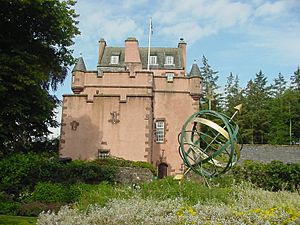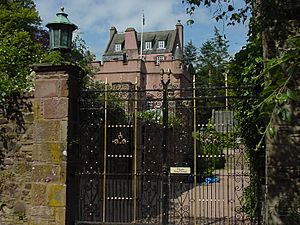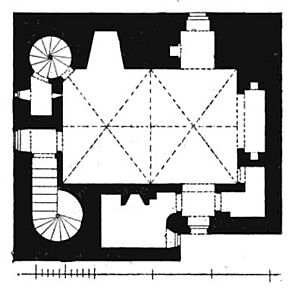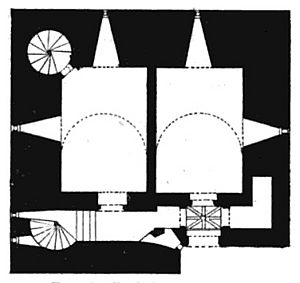Towie Barclay Castle facts for kids
Towie Barclay Castle is an old and important castle located in Aberdeenshire, Scotland. It stands about 4.5 miles south-east of a town called Turriff. The castle you see today was built in 1593 by a powerful family known as Clan Barclay.
The land where the castle sits was given to Clan Barclay way back in the 11th century by Malcolm III of Scotland, who was the King of Scots. A long time ago, in the 12th century, Clan Barclay was involved in taking things from a nunnery (a place where nuns live). After this happened, a famous person named Thomas the Rhymer said a special rhyme: "Towie Barclay of the Glen/Happy to the maids/But never to the men."
People believed this rhyme was a curse on the male members of the Barclay family. This belief was so strong that in 1753, a man named Mr. Barclay Maitland sold the castle to the Earl of Findlater because of it. The Earl also faced bad luck, as his son passed away. So, in 1792, he sold the castle again, this time to Gordon's Hospital in Aberdeen.
The building was sold for £21,000 to the people who ran Robert Gordon's hospital in Aberdeen. Even though the roof was fixed in 1874, Towie Barclay Castle became very run down by the middle of the 20th century.
Discovering the Castle's History
Many years ago, in 1887, a detailed description of Towie Barclay Castle was written. It was part of a book called The Castellated and Domestic Architecture of Scotland from the Twelfth to the Eighteenth Century. This book helped people understand more about old Scottish buildings.
The castle is found in the southern part of the area called Turriff. There's an old stone built into the castle wall with some interesting writing on it. One part says, "Sir Alexander Barclay of Tolly, foundator, deceisit anno domini 1186." This made some people think the castle was built in 1186.
However, experts believe this part of the inscription just records something that happened a long time ago. The stone also has another message: "In tim of Valth al men semis friendly and frindis not knauin but in adversity, 1593." This means "In times of wealth, all men seem friendly, and friends are not known until adversity." This second date, 1593, is when the current castle was actually built.
In 1792, some changes were made to the castle. The decorative towers and battlements (parts of the wall with openings for defense) were removed. Two stories were taken off the top of the main tower, and the ditch around the castle was filled in.
The Barclay family faced difficulties because they supported Mary, Queen of Scots. From 1558 to 1624, the castle was owned by Patrick Barclay. He was the one who wrote the wise message about friends in good times and bad, likely from his own tough experiences.
Castle Design and Special Features
The castle's design is a bit like a simple square tower. It has a small break in the wall near the entrance door. This clever design creates space for a passage to the staircase. It also allows for a narrow opening, called a loophole, that looks out over the entrance.
Inside, a stone pillar protects this loophole. This pillar was placed so people inside could see out, but it would stop anything thrown from outside. The lowest floor of the castle has arched ceilings, called vaults. The small entrance area has a special kind of vaulted ceiling with decorative ribs. This type of ceiling was common in that area.
The basement level had cellars, which are like storage rooms. These cellars had small loopholes for light and defense. One cellar even had a secret staircase leading up to the main hall.
The main staircase goes up to the first floor. It's partly straight, then curves around a corner of the tower. It leads to a good landing right at the door of the main hall.
The great hall is a large room, about 30 feet by 20 feet. It's much more decorated than halls in many other castles. Its ceiling is also vaulted, with ribs and arches springing from carved stone supports. These supports are decorated with carved leaves.
There's also a small, special gallery built into the thick wall above the hall's door. This gallery has a wide opening looking into the hall. It also has ribbed vaulting, and the carvings on the ceiling include the letters "I.H.S." (a symbol for Jesus) and symbols of a heart and pierced hands and feet. The stone supports for the ribs have shields with symbols of the four Evangelists (writers of the Gospels in the Bible).
On each side of the opening into the hall, there are special carved spaces for statues. All these features suggest that this gallery was likely an oratory or a small private chapel. It could be reached by a small staircase from the floor above. This meant the castle owner and their family could use it privately. Or, by pulling back a curtain, it could be opened to the hall, allowing everyone gathered there to watch a religious service.
Experts believe that the person who designed these parts of the castle was likely someone who also designed churches. This type of vaulted ceiling is rare in Scottish castles.
Bringing the Castle Back to Life
In the late 1960s, a musician named Marc Ellington and his wife, Karen, bought Towie Barclay Castle. It was in a very bad state at this time. They decided to bring it back to its former glory.
Marc Ellington used money from his music career to pay for the huge restoration project. His wife, Karen, was the project manager, overseeing all the detailed work. The restoration took more than seven years to finish.
While the lower part of the castle still has its original 16th-century stone walls, the upper floors had to be rebuilt in a modern way. The restoration work was done so well that it won a special Saltire Society Award in 1973. This award recognizes excellent achievements in Scotland.
As of 2008, the Ellington family still owns Towie Barclay Castle. Besides owning the castle, the Ellingtons are also known as Lairds (a Scottish title for a landowner) of nearby places like Gardenstown and Crovie.





